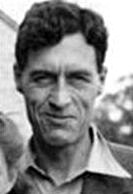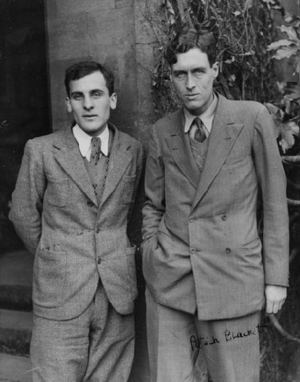Patrick Blackett facts for kids
Quick facts for kids
The Lord Blackett
|
|
|---|---|

Patrick Blackett, ca. 1950
|
|
| Born |
Patrick Maynard Stuart Blackett
18 November 1897 London, England
|
| Died | 13 July 1974 (aged 76) |
| Nationality | British |
| Alma mater |
|
| Known for |
|
| Spouse(s) |
Constanza Bayon
(m. 1924) |
| Children | 2 |
| Awards |
|
| Scientific career | |
| Fields | Physics |
| Institutions | |
| Academic advisors | Ernest Rutherford |
| Doctoral students |
|
| Other notable students | Ishrat Hussain Usmani Imdadul Haque Khan |

Patrick Maynard Stuart Blackett, Baron Blackett (born November 18, 1897 – died July 13, 1974) was a famous British scientist. He was an experimental physicist, which means he did experiments to understand how the world works.
Blackett is best known for his work with cloud chambers, studying cosmic rays, and learning about paleomagnetism. He won the Nobel Prize in Physics in 1948 for his amazing discoveries. In 1925, he was the first person to show that radioactivity could change one chemical element into another. During World War II, he also helped the military with important advice and developed a new field called "operational research." He was a very influential person who cared about helping poorer countries.
Contents
Early Life and Education
Patrick Blackett was born in London, England. His father was a stockbroker, and his mother was Caroline Maynard. He had a younger sister named Marion, who became a psychoanalyst. As a child, Patrick loved building model aeroplanes and listening to his crystal radio.
He joined the Royal Naval College, Osborne when he was young. He then moved to Dartmouth, where he was often the best student in his class.
When World War I started in August 1914, Blackett became a midshipman in the Navy. He served on several ships, including HMS Carnarvon and HMS Barham. He was even at the famous Battle of Jutland. While on HMS Barham, he helped invent a device for aiming guns, which the Navy later patented.
Blackett noticed that the British Navy's gunnery was not as good as it could be. This made him start reading science books to learn more. In 1919, after the war, the Navy sent him to the University of Cambridge. There, he met other smart people and realized he loved intellectual conversations. He decided to leave the Navy to study mathematics and physics at Cambridge.
Career and Research
After finishing his studies in 1921, Blackett worked at the Cavendish Laboratory with a famous scientist named Ernest Rutherford. He became a fellow at King's College, Cambridge in 1923.
Discovering Nuclear Transmutation
Rutherford had found a way to break apart the center (nucleus) of a nitrogen atom by shooting tiny particles called alpha particles at it. He asked Blackett to use a special tool called a cloud chamber to see these changes. A cloud chamber lets you see the paths of tiny particles.
By 1925, Blackett had taken 23,000 photos. These photos showed 415,000 tracks of particles. Eight of these tracks were forked, which meant something new had happened. He discovered that when a nitrogen atom and an alpha particle combined, they formed a fluorine atom. This fluorine atom then broke apart into a type of oxygen and a proton. This was a huge discovery! Blackett was the first person to purposely change one element into another.
Cosmic Rays and Antimatter
In 1932, Blackett worked with Giuseppe Occhialini. They created a system using Geiger counters that would only take pictures when a cosmic ray particle passed through their cloud chamber. Cosmic rays are high-energy particles that come from space.
They took 700 pictures and found 500 tracks of these powerful cosmic ray particles. In 1933, Blackett found fourteen tracks that proved something amazing: the existence of the positron. A positron is like an electron but with a positive charge. This work also showed how positrons and electrons can be created together and how they can destroy each other (called annihilation radiation). This made Blackett one of the first experts on anti-matter.
Leading Research Labs
After his time at Cambridge, Blackett became a professor of Physics at Birkbeck, University of London in 1933. Four years later, in 1937, he moved to the Victoria University of Manchester. There, he became the Langworthy Professor and built a very important international research laboratory. The Blackett Memorial Hall and a lecture theatre at the University of Manchester are named after him.
In 1947, Blackett came up with a theory about the Earth's magnetic field. He thought it might be related to how the Earth spins. He spent years building very sensitive tools called magnetometers to test his idea. Even though his theory turned out to be wrong, his work led him into the field of geophysics. This is the study of the Earth's physical processes. He helped analyze data about paleomagnetism, which is the study of ancient magnetism in rocks. This work provided strong evidence for continental drift, the idea that continents move over time.
In 1948, Blackett received the Nobel Prize in Physics. He won it for his studies of cosmic rays using his special counter-controlled cloud chamber.
In 1953, Blackett became the head of the Physics Department at Imperial College London. He retired in 1963. The physics building at Imperial College, called the Blackett Laboratory, is named in his honor.
World War II and Operational Research
During World War II, Blackett played a crucial role. In 1935, he joined a committee that pushed for the early use of Radar for air defense. Radar helps detect planes and ships. He also helped design the Mark XIV bomb sight, a device that made it easier for planes to drop bombs accurately.
In 1940, Blackett worked on the MAUD Committee, which looked into whether an atomic bomb could be built. He thought Britain couldn't build one alone by 1943 and suggested they talk to the Americans about it.
Developing Operational Research
In 1940, Blackett became a scientific advisor to the head of Anti-Aircraft Command. This was the start of a new field called operational research. This field uses scientific methods to help make better decisions in complex situations, especially in war.
Blackett led operational research for the British Navy from 1942 to 1945. His team's work helped improve the survival rate of convoys (groups of ships traveling together). They also gave surprising but correct advice on how to add armor to aircraft. Blackett believed in using facts and numbers to make decisions, not just feelings.
He disagreed with some military leaders who wanted to focus heavily on bombing German cities. Blackett's studies showed that this bombing was not very effective. Instead, he argued that it was more important to fight the German U-boats (submarines), which were sinking many British merchant ships. His ideas were not popular with everyone at the time. However, after the war, studies proved that Blackett had been right.
Politics and Helping Others
Blackett was a socialist, meaning he believed in fairness and equality for everyone. He often supported the Labour Party. After World War II, he was known for his strong opinions, including his belief that Britain should not develop atomic weapons.
He was a strong supporter of India. In 1947, he met Jawaharlal Nehru, India's first Prime Minister. Blackett advised India on science and technology for their military and for their country's development. These visits made him care deeply about people in poorer countries. He believed that science and technology could solve many of the world's problems. He encouraged other scientists to use their skills to help everyone have a good life.
Blackett suggested that Britain should give 1% of its national income to help poorer countries. He also helped start the Overseas Development Institute, an organization that works to reduce poverty. When Harold Wilson became the leader of the Labour Party, Blackett's ideas became very important. His ideas led to the creation of the Ministry of Technology in the government. He believed that helping the computer industry grow was a top priority.
Personal Life
Blackett was an agnostic or atheist, meaning he did not believe in God or was unsure. He received many honors during his life. He was made a life peer in 1969, becoming Baron Blackett. The greatest honor for him was becoming President of the Royal Society in 1965. The Blackett crater on the Moon is named after him.
Blackett married Constanza Bayon in 1924. They had two children. He is buried in the Kensal Green Cemetery in London.
Many people who knew Blackett spoke highly of him. Bernard Lovell, another scientist, said that Blackett had a very powerful personality but was also sensitive and kind. Edward Bullard said Blackett was the most talented and well-liked physicist of his time. He described him as intelligent, charming, fun, dignified, and handsome.
In 2016, a special blue plaque was placed on the house where Blackett lived in London from 1953 to 1969. This plaque honors important people who lived in that building.
Images for kids
See also
 In Spanish: Patrick Maynard Stuart Blackett para niños
In Spanish: Patrick Maynard Stuart Blackett para niños



